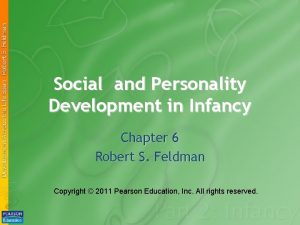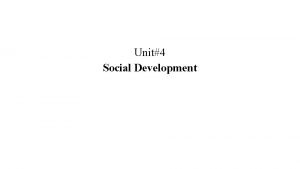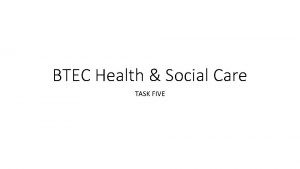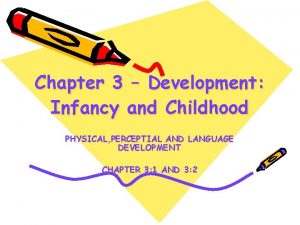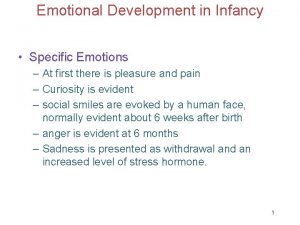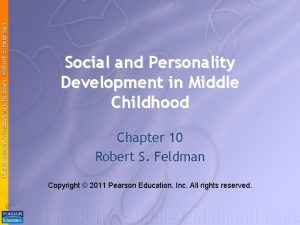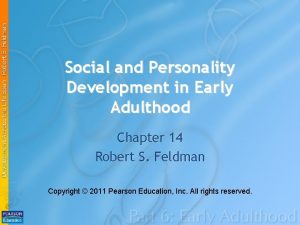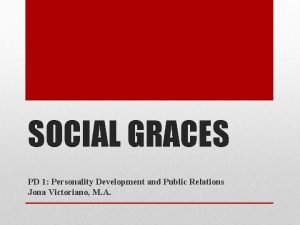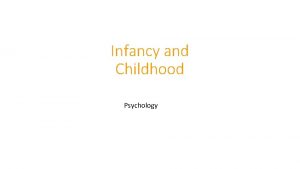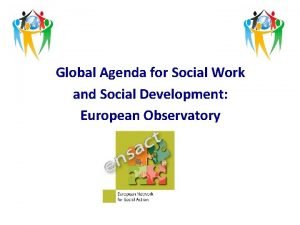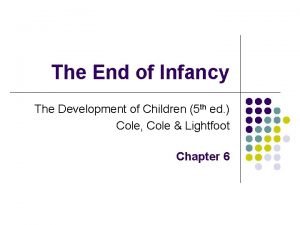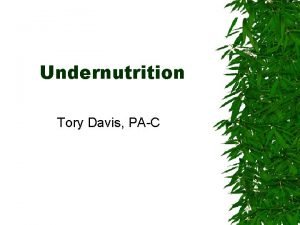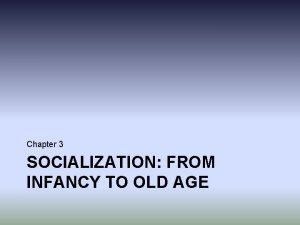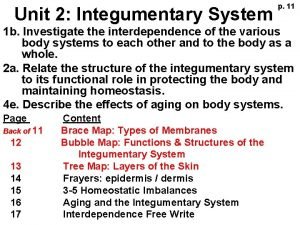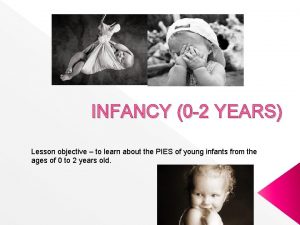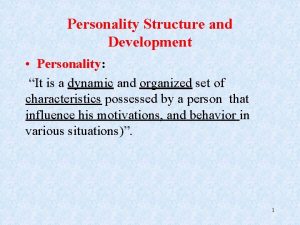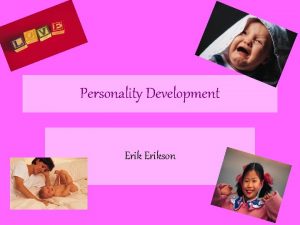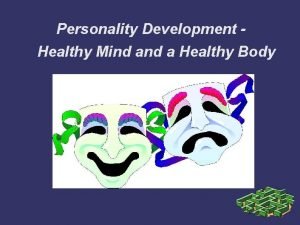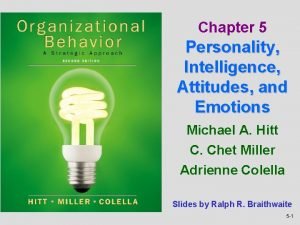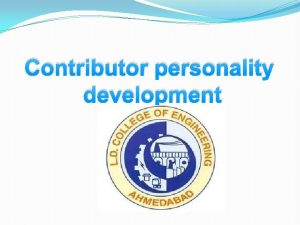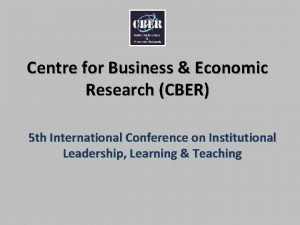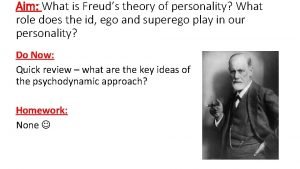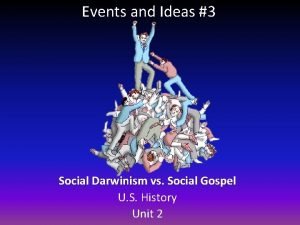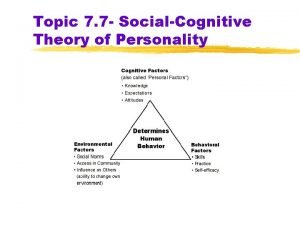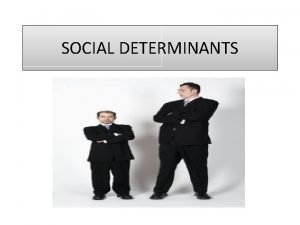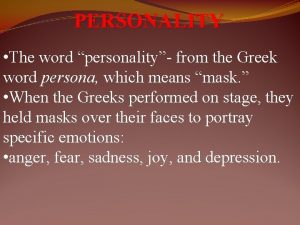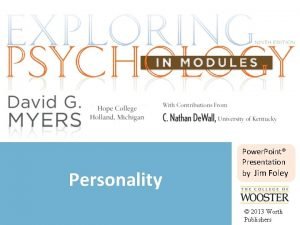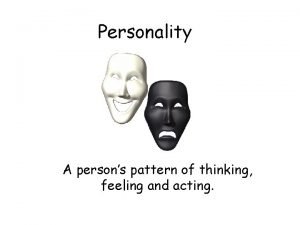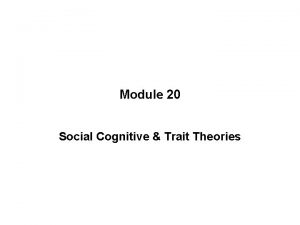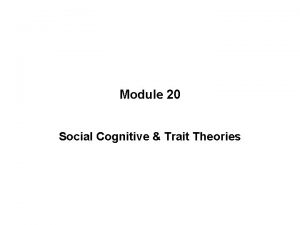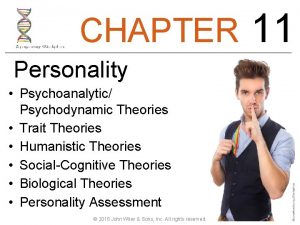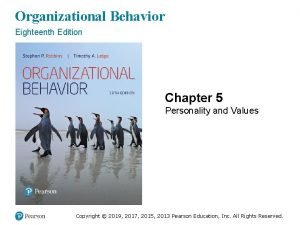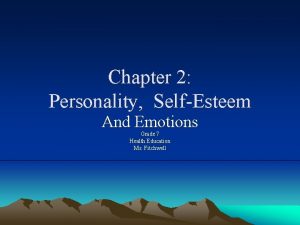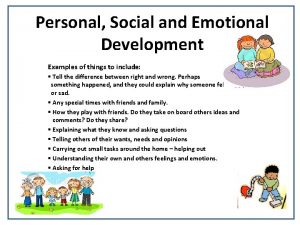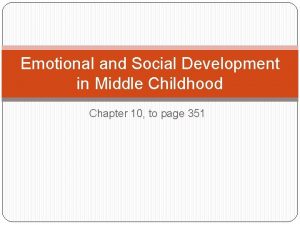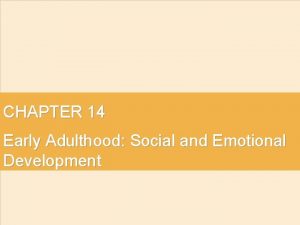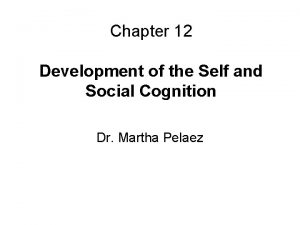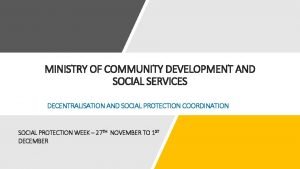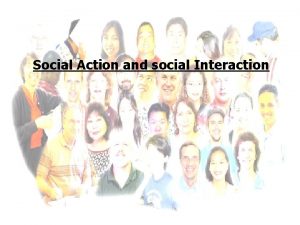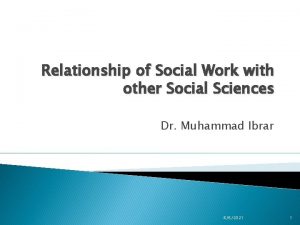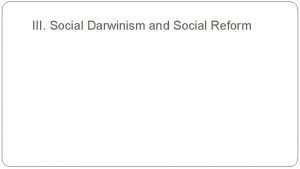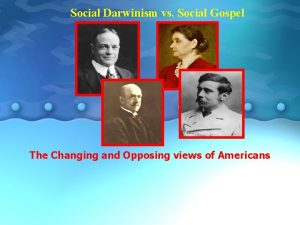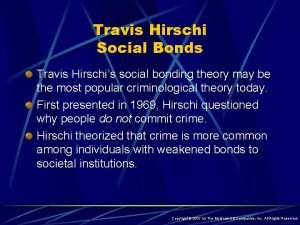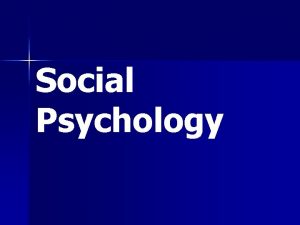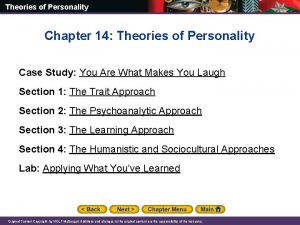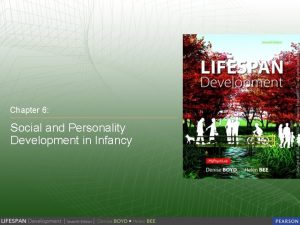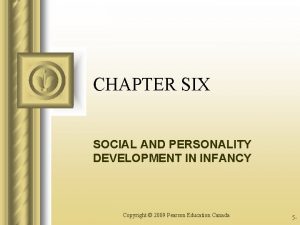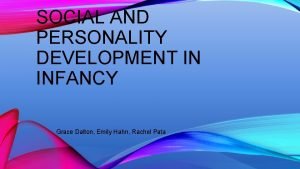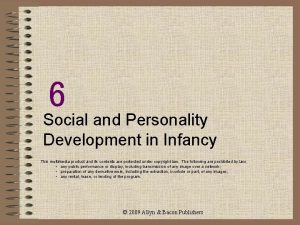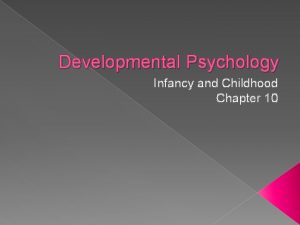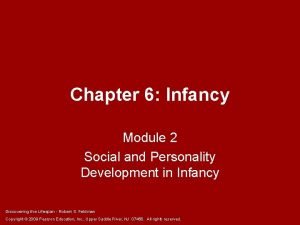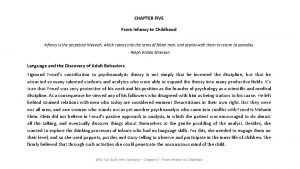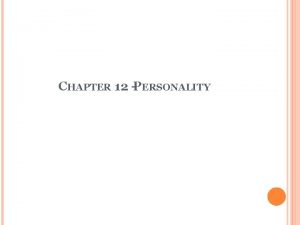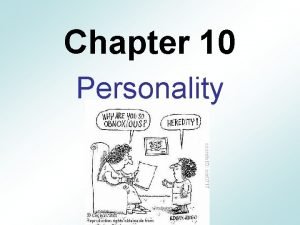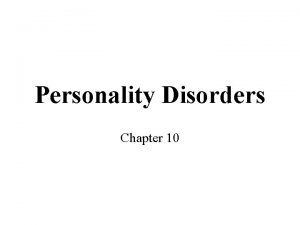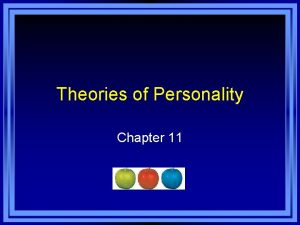Social and Personality Development in Infancy Chapter 6













































































- Slides: 77

Social and Personality Development in Infancy Chapter 6 Robert S. Feldman Copyright © 2011 Pearson Education, Inc. All rights reserved.

Looking Ahead Do infants experience emotions? What sort of mental lives do infants have? What is attachment in infancy and how does it affect a person’s future social competence? What roles do other people play in infants’ social development? What individual differences distinguish one infant from another? How does non-parental child care impact infants?

DEVELOPING THE ROOTS OF SOCIABILITY

Basic Familiar Expressions • Remarkably similar across the most diverse cultures • Nonverbal encoding fairly consistent among people of all ages

Infant Emotional Expressions Izard (MAX) At birth: Interest Distress Disgust Over next months: Clues of other emotions emerge Kinds and degree of emotions expressed vary Mirrors Darwin’s earlier findings

Facial Expression of Emotions Important nonverbal communication tool used in everyday social interactions • Write down four emotions. • Turn to the person on your left and without saying anything display the emotions you have recorded one at a time. • Ask your partner to record the emotions he or she sees. • How did you and your partner do? What helped (or hindered) understanding of the emotions you were trying to convey?

But…what are emotions? True emotions have three components: 1. Biological arousal 2. Cognitive component 3. Behavioral components

Interpreting Infant Emotional Expressions Two Different Views • Infants display adult-like nonverbal expressions • If displays are innate, facial expressions may occur without accompanying cognitive referents -reflexive • Infant nonverbal expressions represent emotional experiences • Expressions may help to regulate emotion as basic expressions are modified and better controlled with age -- adaptive

When young feelings and hearts meet… • Advances in infants’ emotional life are made possible by increasing sophistication of brain • Initially, differentiation of emotions occurs as cerebral cortex becomes operative in first three months of life • By age of 9 or 10 months, structures that make up limbic system (the site of emotional reactions) begin to grow • Limbic system starts to work in tandem with frontal lobes, allowing for increased range of emotions

Who IS that strange person, anyway? Stranger anxiety Memory develops ability to recognize familiar people emerges abililty to anticipate and predict events increases appearance of unknown person causes fear Common around 6 months Significant difference among infants and situations

Separation Anxiety • Distress displayed by infants when a customary care provider departs

Separation Anxiety Universal across cultures Begins about 7 -8 months; peaks around 14 months Largely attributable to same reasons as stranger anxiety

Smiling Earliest smiles: little meaning 6 to 9 weeks: Begin reliable smiling Smile first relatively indiscriminate then selective 18 months: Social smiling more frequent toward humans than nonhuman objects End of 2 nd year: Use smiling purposefully Show sensitivity to emotional expressions of others

Decoding Others’ Facial and Vocal Expressions Imitative abilities early in life may pave way for nonverbal decoding Infants interpret others’ facial and vocal expressions that carry meaning In first 6 to 8 weeks By 4 months By 5 months By 7 months

If you’re happy and she knows it… Social referencing First occurs around 8 -9 months Intentional search for cues Aids in understanding others’ behavior in context

How does social referencing operate? Two views: 1. Observing someone else’s facial expression brings about emotion expression represents 2. Viewing another’s facial expression simply provides information

Do infants really know who they are?

Development of Self-Awareness Roots of self-awareness Begin to grow around 12 months Influenced by cultural upbringing Research Rouge spot Average awareness begins 17 to 24 months Complicated tasks requests Awareness of inabilities around 23 -24 months

Just Think About That! Theory of mind Knowledge and beliefs how mind works and influences behavior Child explanations used to explain how others think

How does a theory of mind develop? See other people as compliant agents Begin to understand causality and intentionality Demonstrate rudiments of empathy Begin to use deception to fool others

Review and Apply REVIEW Infants appear to express and to experience emotions, and their ____ broaden in range to reflect increasingly ____ emotional states. Infants from all cultures use ____ facial expressions to express basic emotional ____. As they develop cognitively and begin to distinguish ____ from ____ people, infants begin to experience stranger anxiety at about ____ months and separation anxiety at around ____ months of age.

Review and Apply REVIEW The ability to decode the ____ facial and vocal expressions of others develops early in infants. The use of nonverbal decoding to clarify situations of uncertainty and determine appropriate responses is called ____. Infants develop ____, the knowledge that they exist separately from the rest of the world, after about ____ months of age. By the age of 2, children have developed the rudiments of a ____.

Review and Apply APPLY Why would the sad or flat emotional expressiveness of a depressed parent be hard on an infant? How might it be counteracted? In what situations do adults rely on social referencing to work out appropriate responses? How might social referencing be used to influence parent’s behavior toward their children?

FORMING RELATIONSHIPS

What is attachment? Attachment Positive emotional bond that develops between a child and a particular, special individual Most important aspect of infant social development

Understanding Attachment • Earliest animal research suggests attachment based on biologically determined factors – Lorenz imprinted goslings – Harlow contact-seeking monkeys

Understanding Attachment Earliest human research suggests attachment based on needs for safety and security Bowlby: – Attachment provides home base through qualitatively unique relationship with individual who best provides safety – As children become more independent, they progressively roam further away from their secure base

How Strange! Ainsworth Strange Situation – Widely used experimental technique to measure attachment – Sequence of staged episodes that illustrate strength of attachment between child and (typically) mother

Do all infants attach? • Reactions to Strange Situation vary considerably • One-year-olds typically show one of four major patterns

And then there were four… Recent expansion of Ainsworth work suggests fourth category: disorganized-disoriented Inconsistent, contradictory, and confused behavior May be least securely attached

Does the quality of attachment have significant consequences for later life relationships? Yes But • Securely attached 1 - year-old males show fewer psychological difficulties at older ages • Children who do not have a secure attachment style during infancy do not invariably experience difficulties later in life • Children with a secure attachment at age 1 do not always have good adjustment later in life • Securely attached infants are more socially and emotionally competent later and more positively viewed • Adult romantic relationships are associated with attachment style developed during infancy

What roles do parents play in producing attachment? Mothers Sensitivity to their infants’ needs and desires is hallmark of mothers of securely attached infants • • • Aware of moods and feelings Responsive in face-to-face interactions Feeds “on demand” Demonstrates warmth and affection Responds rapidly and positively to cues

How do mothers learn to respond? Mothers learn from – Generational attachment patterns – Infant’s ability to provide effective cues

What roles do parents play in producing attachment? Fathers Expressions of nurturance, warmth, affection, support, and concern are extremely important to infant emotional and social well-being

Do all infants attach to only one parent? Infants’ social bonds extend beyond their parents, especially as they grow older • Most infants form their first primary relationship with one person • One-third have multiple relationships • By 18 months, most infants have formed multiple relationships

Baby loves ME best…or maybe just differently Nature of maternal and paternal attachment differs Qualitative difference related to what parents do with infants

So…what DO parents do all day? Mothers feed and nurture and fathers play…

Cultural Differences in ways fathers and mothers play with their children occur in many US families and in very diverse cultures How then does culture affect attachment?

Developmental Diversity Does attachment differ across cultures? Research findings suggest human attachment is not as culturally universal as Bowlby predicted Certain attachment patterns seem more likely among infants of particular cultures: Germany Israel and Japan China and Canada

Which conclusion is “Right”?

Feldman’s Conclusions Attachment is viewed as susceptible to cultural norms and expectations Cross-cultural and within-cultural differences reflect nature of measure employed and expectations of various cultures

Feldman’s Conclusions Attachment should be viewed as a general tendency, that varies in way it is expressed according to how actively caregivers in a society seek to instill independence in their children

Feldman’s Conclusions Secure attachment, as defined by the Westernoriented Strange Situation, is seen earliest in cultures that promote independence, but may be delayed in societies in which independence is less important cultural value

Developing Working Relationships Relationship development is ongoing process Communication of emotional states facilitated through mutual regulation model Young infants are able to read, or decode, and react to facial expressions of their caregivers through reciprocal socialization

Infant-Caregiver Interaction

Hey Baby, Baby! Babies react positively to presence of peers from early in life and engage in rudimentary forms of social interaction Infants’ sociability is expressed in several ways: Earliest months of life Nine- to twelve-month-olds

“Expert” Infants With age, infants begin to imitate each other Impart information and skills from “experts” infant peers May be inborn skill

Mirror, mirror, in the brain… Mirror neurons Fire not only when an individual enacts particular behavior, but also when individual simply observes another organism carrying out same behavior Help infants understand others’ actions and to develop theory of mind Dysfunction may be related to some developmental disorders

Review and Apply REVIEW ____, the positive emotional bond between an infant and a significant individual, affects a person’s later ____ as an adult. By the amount of emotion they display ____, infants help determine the ____ and ____ of their caregivers’ responses to them.

Review and Apply REVIEW Infants and the persons with whom they interact engage in ____ socialization as they ____ adjust to one another’s interactions. Infants react differently to other ____ than to ____ objects, and gradually they engage in increasing amounts of peer ____.

Review and Apply APPLY In what sort of society might an avoidant attachment style be encouraged by cultural attitudes toward child rearing? In such a society, would characterizing the infant’s consistent avoidance of its mother as anger be an accurate interpretation? What might a social worker seeking to find a good home for a foster child look for when evaluating potential foster parents?

DIFFERENCES AMONG INFANTS

Characteristics That Make Infants Unique Personality Sum total of enduring characteristics differentiating one individual from another From birth onward, infants begin to show unique, stable traits and behaviors that ultimately lead to their development as distinct, special individuals

What were YOU like?

Erikson: Psychosocial Development Early experiences responsible for shaping key aspects of personalities Stage 1: trust versus mistrust Trust = sense of hope and success Mistrust = sense of harsh, unfriendly world Stage 2: autonomy-versus-shame-and-doubt stage Autonomy = sense of independence Shame and doubt = sense of self-doubt and unhappiness

Another View: Temperament and Stabilities in Infant Behavior What is temperament?

How does temperament apply to infants? Temperament Refers to how children behave, as opposed to what they do or why they do it Displays as differences in general disposition from birth, largely due initially to genetic factors Tends to be fairly stable well into adolescence Is not fixed and unchangeable and can be modified by childrearing practices

Dimensions of Temperament • Activity level • Irritability

Categorizing Temperament Babies can be described according to one of several temperament profiles: Easy babies Difficult babies Slow-to-warm up babies Inconsistently categorized babies Thomas and Chess, 1980

Does temperament matter?

Biological Basis of Temperament Recent approaches to temperament grow out of behavioral genetics framework Physiological reactivity to novel stimuli Clear biological basis underlying inhibition to the unfamiliar Rapid increase in heartbeat, blood pressure, pupil dilation, and high excitability of brain’s limbic system

True or false? Behavior exhibited by girls and boys is interpreted in very different ways by adults.

How is this difference manifested? • Parent-child play patterns • Different styles of activity and interaction from parents • Parental gender-based interpretation of child behavior

Gender Differences Adults view behavior of children through lens of gender All cultures prescribe gender roles for males and females These roles differ greatly between cultures Considerable amount of disagreement over extent and causes of gender differences Differences between male and female infants, are generally minor

Gender Roles Gender differences emerge with age By age 1: Able to distinguish between males and females Girls prefer to play with dolls or stuffed animals, while boys seek out blocks and trucks By age 2: Boys behave more independently and less compliantly than girls May be reinforced by parental choices or by levels hormonal levels

And so… • Differences in behavior between boys and girls begin in infancy and continue throughout childhood (and beyond) • Although gender differences have complex causes, representing some combination of innate, biologically related factors and environmental factors • These differences play profound role in social and emotional development of infants

Family Life in 21 st Century Number of single-parent families has increased dramatically in last two decades Average size of families is shrinking Despite overall decline, half million births to teenage women, the vast majority of whom are unmarried Close to 50 percent of children under age of 3 are cared for by other adults while their parents work, and more than half of mothers of infants work outside home One in three US children lives in low income households

From Research to Practice How Does Infant Care Affect Later Development?

Good news, bad news! Good news: Direct benefits • High-quality child care outside home produces only minor differences Good news: Indirect benefits • Children in lower income households and those whose mothers are single may benefit Bad news: • Infants less secure when in low-quality child care • Children who spend long hours lower have ability to work independently • Children who spend ten or more hours a week in group child care for a year or more have an increased probability of being disruptive in class

How would you. . . Advise a new parent about research-based, potential effects of child care on their newborn? Identify a quality child care center in your own town or city?

Becoming an Informed Consumer of Development Choosing the Right Infant Care Provider The American Psychological Association suggests that parents consider these questions in choosing a program: Are there enough providers? Are group sizes manageable? Has the center complied with all governmental regulations, and is it licensed? Do the people providing the care seem to like what they are doing?

Becoming an Informed Consumer of Development Choosing the Right Infant Care Provider The American Psychological Association suggests that parents consider these questions in choosing a program: What do the caregivers do during the day? Are the children safe and clean? What training do the providers have in caring for children? Is the environment happy and cheerful?

Review and Apply REVIEW According to ____, during infancy individuals move from the ____ stage of psychosocial development to the ____ stage. Temperament encompasses enduring levels of ____ and ____ that are characteristic of an individual. ____ differences become more pronounced as infants age.

Review and Apply REVIEW Child care outside of the home can have neutral, positive, or negative effects on the ____ development of children, depending largely on its ____. Research on the ____ of child care must take into account the varying quality of different child-care ____ and the ____ characteristics of the parents who tend to use child care.

Review and Apply APPLY If you were introducing a bill in Congress regarding the minimum licensing requirements for child care centers, what would you emphasize? Imagine you are a social worker visiting a foster home. It is 11 am. You find the breakfast dishes in the sink and books and toys all over the floor. The infant you have placed in the home is happily pounding on pots and pans as his foster mother claps time. The kitchen floor is gooey under the baby’s high chair. What is your assessment?

EPILOGUE Return to the prologue of this chapter, about Russell Ruud’s Velcro discovery, and answer the following questions. Is this episode evidence of self-awareness on the part of Russell or his child-care companions? Why or why not? What role do you think social referencing might have played in this scenario? If Russell’s care providers had reacted negatively, would this have stopped the other children from imitating Russell?

EPILOGUE How does this story relate to the sociability of infants? Can we form any opinion about Russell’s personality based on this event? Why or why not? Do you think Russell’s actions might have brought a different response from his adult care providers if he had been a girl? Would the response from his peers have been different? Why or why not?
 Personality development in infancy
Personality development in infancy Infants display a wide range of emotional expressions
Infants display a wide range of emotional expressions Social development in infancy and childhood
Social development in infancy and childhood What is intellectual development in health and social care
What is intellectual development in health and social care Chapter 5 cognitive development in infancy and toddlerhood
Chapter 5 cognitive development in infancy and toddlerhood Module 47 infancy and childhood cognitive development
Module 47 infancy and childhood cognitive development Social development in late childhood
Social development in late childhood Infancy and childhood physical development
Infancy and childhood physical development Module 46 infancy and childhood physical development
Module 46 infancy and childhood physical development Module 47 infancy and childhood cognitive development
Module 47 infancy and childhood cognitive development Socioemotional development in infancy
Socioemotional development in infancy Chapter 7 human growth and development
Chapter 7 human growth and development Steps of growth and development
Steps of growth and development New emotions that appear toward the second year
New emotions that appear toward the second year Chapter 10 infancy and childhood
Chapter 10 infancy and childhood Chapter 10 infancy and childhood review worksheet answers
Chapter 10 infancy and childhood review worksheet answers Chapter 10 infancy and childhood review worksheet answers
Chapter 10 infancy and childhood review worksheet answers Damon's stages of friendship
Damon's stages of friendship Social and personality development in early adulthood
Social and personality development in early adulthood Personality traits
Personality traits Infancy and childhood psychology
Infancy and childhood psychology Lesson quiz 3-2 infancy and childhood
Lesson quiz 3-2 infancy and childhood Global agenda for social work and social development
Global agenda for social work and social development Infancy period
Infancy period Early childhood adolescence
Early childhood adolescence Infancy
Infancy Infancy physical changes
Infancy physical changes Catastrophic epilepsy infancy
Catastrophic epilepsy infancy Anna isabelle and genie
Anna isabelle and genie Infancy childhood adolescence adulthood old age
Infancy childhood adolescence adulthood old age Pies in infancy
Pies in infancy Problems of infancy
Problems of infancy For adult
For adult Messianic prophecies fulfilled in the infancy narratives
Messianic prophecies fulfilled in the infancy narratives Social thinking social influence social relations
Social thinking social influence social relations Social thinking social influence social relations
Social thinking social influence social relations Undoing defense mechanism examples
Undoing defense mechanism examples Trust vs mistrust
Trust vs mistrust Physical defects in personality development
Physical defects in personality development Summary of personality development
Summary of personality development Determinants of personality development
Determinants of personality development Contributor and non contributor
Contributor and non contributor Conclusion personality
Conclusion personality Freud's 3 components of personality
Freud's 3 components of personality Contributor personality development
Contributor personality development Social darwinism vs social gospel
Social darwinism vs social gospel Cognitive perspective of personality
Cognitive perspective of personality Social determinants of personality
Social determinants of personality Trait theories
Trait theories Social cognitive personality
Social cognitive personality 16 source traits
16 source traits Social cognitive approaches to personality
Social cognitive approaches to personality Reaction formation defense mechanism
Reaction formation defense mechanism Bandura social cognitive theory of personality
Bandura social cognitive theory of personality Trait theory vs social cognitive theory
Trait theory vs social cognitive theory Psychodynamic vs psychoanalytic
Psychodynamic vs psychoanalytic Four defense mechanisms
Four defense mechanisms Organizational behavior chapter 5
Organizational behavior chapter 5 Chapter 5 personality and values
Chapter 5 personality and values Chapter 2 personality self-esteem and emotions
Chapter 2 personality self-esteem and emotions Fictional character examples
Fictional character examples Social development in middle childhood
Social development in middle childhood Social development of middle adulthood
Social development of middle adulthood Emotional growth
Emotional growth Development of self and social understanding
Development of self and social understanding Ministry of community development and social services
Ministry of community development and social services Social and emotional development in late adulthood
Social and emotional development in late adulthood Diversity and human needs and development
Diversity and human needs and development Difference between social action and social interaction pdf
Difference between social action and social interaction pdf Social work and other social sciences
Social work and other social sciences Social thinking and social influence
Social thinking and social influence Lesson 3 social darwinism and social reform
Lesson 3 social darwinism and social reform Social darwinism vs social gospel venn diagram
Social darwinism vs social gospel venn diagram Social gospel vs social darwinism
Social gospel vs social darwinism Social bonding theory
Social bonding theory Social thinking and attribution theory
Social thinking and attribution theory Chapter 14 theories of personality worksheet answers
Chapter 14 theories of personality worksheet answers Origins of community development
Origins of community development
